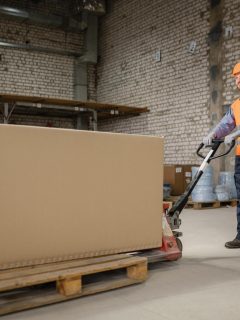The strapping of parcels and pallets is one of the key elements of the order preparation process, as it ensures the safety of your goods during transport. At the heart of this process is a key tool: strapping. In this article, you will find a brief guide on how to choose your strapping tapes, as well as all the machines and accessories you need for efficient and ergonomic bale and pallet strapping.
What type of strapping tape should I choose?
There are several types of strapping tapes. Their choice depends on the parcels you plan to tape, as well as the type of storage you plan to use.
|
Type of tape |
Features | For what type of cargo? |
Application and sealing |
| Paper tapes |
|
|
|
| Polypropylene (PP) tapes |
|
|
|
| Polyester tapes |
|
|
|
| Textile tapes |
|
|
|
What are the tapes used for?
Tapes are used to enclose, secure or group goods in such a way that they cannot move during transport (in a bale or on a pallet). However, not all types of tie-down tapes are suitable for all types of goods. You need to make sure that the one you choose allows your products to be stored and transported safely.
|
Tape type |
For what use? |
| Paper tapes |
|
| Polypropylene (PP) tapes |
|
| Polyester tapes |
|
| Textile tapes |
|
Taping techniques to be used
Do you need to know how to tape your parcels or pallets? You have two options: either do it by hand or get a machine that mechanises or automates the packaging process. Here’s how to do it.
Manual strapping
Manual strapping should only be used if you have several dozen shipments to strap per day. Exceeding that number exposes your operators to a potential risk of strapping in logistics: musculoskeletal disorders.
When hand strapping parcels, the type of tape you use is important:
For PP, paper or fabric tapes, use a loop and tensioner. Simply make two loops on the binding tape and attach them to the buckle. In the next step, you can tighten the tape in two ways, either by hand or with a tensioner.
To tape PP, steel or polyester tape, use a manual strapping machine (which includes the tensioner and buckle) as well as strapping pliers. Insert the clip and tape into the pliers, then tension the tape using the tensioner and secure the pliers.
Mechanised or automated strapping techniques
Does your warehouse need to handle a large number of bale or pallet strapping operations? To prevent the risk of musculoskeletal disorders in operators and reduce the workload in your warehouse, incorporate strapping machines into your order preparation processes.
Several options are available:
Mobile strapping machines (semi-automatic or automatic) are battery powered and can be moved anywhere in the warehouse. These machines help the operator to strap 70 to 150 bales per day.
Semi-automatic strapping machines bale strapping machines (or table-top strapping machines) can be used to strap packages of different shapes and sizes or for simple product grouping. They assist operators in strapping and allow them to remain upright while working.
4 essential strapping accessories to get
Don’t leave without thinking about these four strapping accessories. These accessories will improve the protection of your shipments and the productivity of your warehouse operators!
- Protective corners allow you to protect the edges of boxes – especially if they contain very fragile products.
- Part of unwrapping trolley is an unwinding tool for easy handling of your tape rolls.
- Self-locking clips made of plastic or steel hold the tapes firmly to the boxes being transported.
- The tape holder is a handy accessory that makes it easier to slide the tape under the pallet, thus reducing the physical strain on the back, especially to reduce the risk of musculoskeletal disorders during manual palletizing!
Now you have the strapping tapes and best practices to achieve efficient and ergonomic strapping of bales and pallets. Now it’s up to you!














